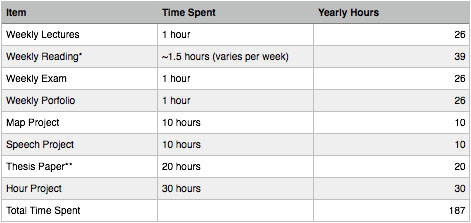WHAT YOU NEED TO GET STARTED
Lesson Videos
- Available on DVD, as digital downloads, and streamed as an individual subscription or as part of the Compass Classroom Membership
- 27 lessons with 5 videos each; additional videos explain the quarterly projects
Student Reader
- Available as digital files with your purchase, or as a separate download or printed book (335 pages)
- Includes daily readings, assignments, and weekly exams.
Portfolio
- Essentially a scrapbook or a visual textbook for the semester’s lessons which shows the lessons that have been verbally discussed.
- Provided by the student: a scrapbook, photo album, 3-ring binder, or a fine sketchbook of durable quality such as card stock or a heavy drawing paper.
Teacher’s Guide
- Scope & Sequence for two semesters of Middle/High School (Ages 13+)
- Portfolio & Project Guide
- Grading Guides for Exams, Readings, the Portfolio, and Projects
- Suggested Literature Titles to go along with most of the 27 Lessons
- Exam Answer Key
Supplementary Audio Products
- Modernity Songs — 2-3 minute recordings of election songs and popular songs from WWI and WWII. For use with the second semester of Dave Raymond’s Modernity course.
- Modernity Stories — Audio files of broadcasts, historical addresses, speeches and events that originally aired on the radio. For use with the second semester of Dave Raymond’s Modernity course.
- Alexis de Tocqueville’s Democracy in America
- Mr. President
- You Are There
- The Cavalcade of America
Need help organizing the digital curriculum? We’ve got a helpful entry on our blog that covers just that!
HOW DAVE RAYMOND’S MODERNITY WORKS
There are a number of different elements to this curriculum that make it quite unique.
Once you see how everything works together, however, it should be fairly easy to teach. You will also want to watch all five parts of Lesson 1 – Orientation. The entire curriculum is explained in detail there.
The class is designed to fill two semesters. It covers 27 Lessons with the goal of completing one Lesson per week. Each Lesson is broken down into five different lectures (approximately 20 minutes each) with associated readings or assignments.
Each day, plan on scheduling approx. 20 minutes for the video and 15 minutes for the daily reading and questions.
Each week, budget approximately 20 minutes for the exam, and another 20 for the Lesson’s Portfolio entry. These elements can be modified to suit the age and frame of your student. For example, parents of middle school students might remove the daily readings to concentrate on the Portfolio, and integrate the Exam questions as a summary of the applicable lesson video.
You can assign one lecture a day or you can go through two or more lectures in one day. Your student will be the best gauge as to how much he or she can effectively cover at one time.
The readings in the second semester of this series are often much longer than the readings in the first half. As the teacher, feel free to abridge any of the writings to more appropriately challenge your student.
One Lesson is normally completed per week. Use the included chart (sample) to mark off what has been finished. Only exams, essays and projects are scored.
If an Assignment asks one or more questions, these are meant to be considered by the student as he or she does the reading. You can also use these questions as a way to discuss the lesson with your student after the lesson and readings are complete.
CALCULATING HIGH SCHOOL CREDIT FOR HISTORY

HSLDA recommends spending approximately 150 hours on a subject to qualify for high school credit.
This is how Dave Raymond’s classes generally break down to achieve that credit. Some students will spend more time in some areas and some will spend less, but there is clearly enough different types of work to qualify for full high school credit.
The reader includes over 300 pages of original historical materials. It increases in length as the year progresses. For example, Lessons in the first semester comprise approximately 140 pages while those in the second comprise approximately 190 pages. If additional reading is desired for older students, we include recommendations for that.
If a parent desires to do two or more thesis papers for older students, that is perfectly acceptable and will only increase the amount of time spent in the class.
Suggested Titles for Further Reading
Lesson 1: Goodbye, Mr. Chips by James Hutton
Lesson 2: Rasselas by Samuel Johnson
Lesson 5: The Scarlet Pimpernel by Baroness Emmuska Orczy
Lesson 6: A Tale of Two Cities by Charles Dickens
Lesson 7: The Antiquary by Sir Walter Scott
Lesson 9: Pride and Prejudice by Jane Austen
Lesson 10: The Portable Romantic Poets edited by W.H. Auden
Lesson 13: Silas Marner by George Eliot
Lesson 15: The Man Who Was Thursday by G.K. Chesterton
Lesson 16: Greenmantle by John Buchan
Lesson 19: The Lord of the Rings by J.R.R. Tolkien
Lesson 21: Brideshead Revisited by Evelyn Waugh
Lesson 23: The Nine Tailors by Dorothy Sayers
Lesson 24: The Space Trilogy by C.S. Lewis
Lesson 26: One Day in the Life of Ivan Denisovich by Alexander Solzhenitsyn
Lesson 27: Brave New World by Aldous Huxley
